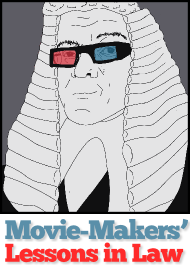Law lessons from the movie makers: Judgment at Nuremberg (1961) – Prof. Penny Cooper
 In the opening scenes we see Judge Haywood (Spencer Tracey) arriving in a bombed-out Nuremberg. It’s two years after the end of World War II and America is losing interest in the war trials. Even so Haywood, a former elected District Court judge from America, is there to try four German judges accused of crimes against humanity.
In the opening scenes we see Judge Haywood (Spencer Tracey) arriving in a bombed-out Nuremberg. It’s two years after the end of World War II and America is losing interest in the war trials. Even so Haywood, a former elected District Court judge from America, is there to try four German judges accused of crimes against humanity.
Most of the movie takes place in the courtroom where Judge Haywood is the epitome of fairness. Outside it he dislikes formality. He goes out of his way to try to understand how ordinary German people lived under Hitler and questions how they carried on if they knew what was going on in the death camps like Dachau.
Both prosecution and defence are experienced and skilled but, perhaps understandably, fail to remain detached and unemotional. It’s painful to watch the cross-examination of Peterson (Montgomery Clift), a baker’s helper who was sterilized against his will (and according to him against the medics’ better judgement) by a court order issued by one of the defendant judges. The film does not hide from the uncomfortable truth that eugenics, including compulsory sterilisation for the ‘feeble minded’, was widely practised around the world. Defence counsel quotes America’s famous jurist Oliver Wendell Holmes to make that point (see Buck v. Bell 274 U.S. 200 (1927)). The prosecutor counters with the point that the difference is that under the Nazis it was used as a political tool.
Irene Wallner (Judy Garland) is a scared and reluctant witness. As with Clift’s performance we are reminded that an adversarial system for testing the truth can also re victimise the vulnerable witness. ‘They are not for picking over disdainfully like some laboratory specimen. There are some truly awful advocates who treat witnesses appallingly’ – Iain Morley, The Devil’s Advocate (2005).
Apart from witness testimony, the prosecution plays footage of tattooed children from concentration camps, of communal death showers and of piles of corpses being bull-dozed into mass graves. It’s horrifying but in order to understand the film we need to see it.
I cannot put it better than UCLA Law School’s Michael Asimow (in Judges Judging Judges—Judgment at Nuremberg, August 1998):
‘The questions raised by Judgment at Nuremberg go to the core of what we do and what we are. What does it mean to be a lawyer, professor, or judge?
…Every judge, lawyer, law student and law professor should see Judgment at Nuremberg. If you saw it years ago, see it again.’
I first saw Judgment at Nuremberg (Abby Mann wrote the play and the movie) when I was invited to a charity production by lawyers at The Tricycle Theatre in 2011. I felt compelled to buy the DVD of the movie and I watched it with my fourteen year old son. Don’t wait as long as I did to see it for the first time.
Penny specialises in witness evidence and never ceases to be fascinated by anything to do with the courtroom. She carries out research into witness issues and teaches judges and barristers about witness handling methods. As often as possible she likes to get a good DVD, a big bag of popcorn and hold a family film festival.
© Penny Cooper, 18 November 2012
